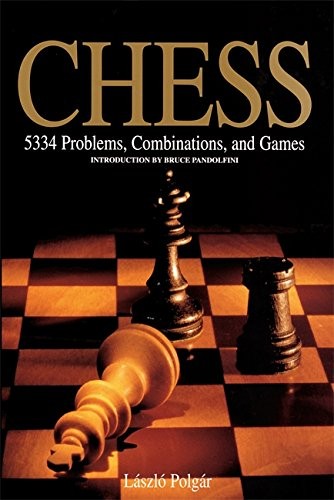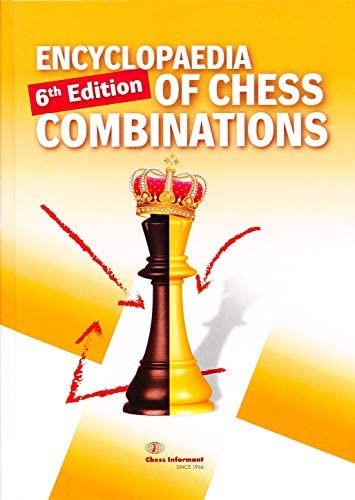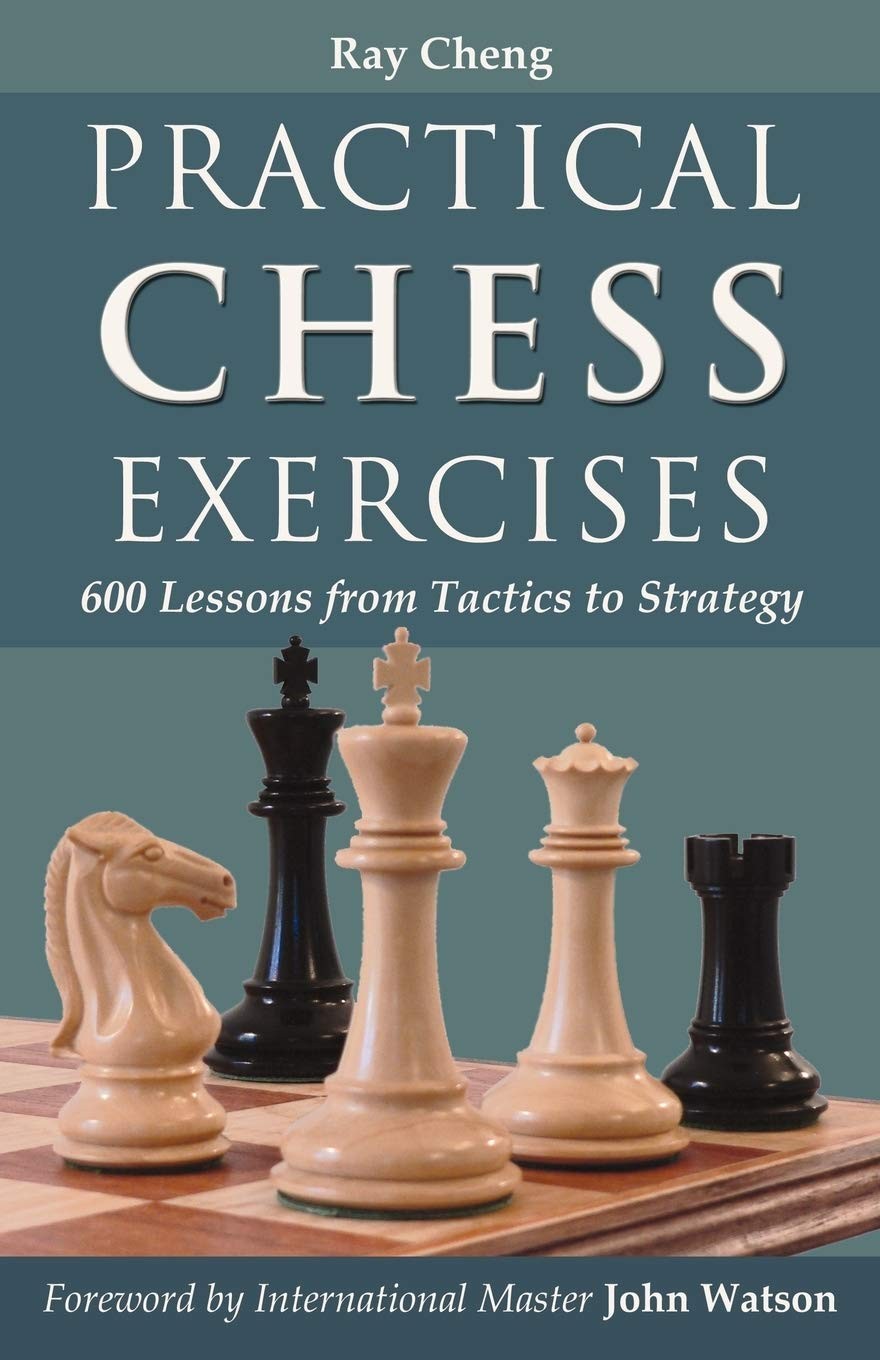
Chess Books - Intermediate Exercise Books
In my last post, Chess Books - Exercise books, I listed some good puzzle books for the beginner to intermediate level. In this post, I'll continue with more challenging puzzle books.
I recommend that you move on to this list when you've reached a rating of about 1400-1500 Chess.com Rapid, or you've finished the previous list and find yourself bored. In general, a good rule of thumb to follow is The Eighty-Five Percent Rule discussed in this post by Martin B. Justesen: ARE CHESS TACTICS TOO HARD? 📈. You want the puzzles to be hard enough that you're getting about 85% of them right. I find that most beginners solve puzzles that are too hard for them, but I also find some intermediate players (read: above 1400 Chess.com Rapid) who like to start at the beginning and solve really easy problems. If you enjoy doing this, then by all means, but some players find this dull and discouraging.
Note that I've also limited this list to books that are meant as puzzle books rather than instructive manuals (like Martin Weteschnik's excellent book Chess Tactics from Scratch), books that are still generally available, and also that are focused mainly on tactical problems, rather than positional problems (like Eugene Perelshteyn & Nate Solon's Evaluate LIke a Grandmaster). I also left out Yusupov's series and Aagaard's books on calculation, even though I've seen some people refer to them as puzzle books because I think they are meant to be studied differently than typical tactics exercise books.
First off are the subsequent books in the series I introduced in the previous post. The second volume of The Manual of Chess Combinations, also by Sergei Ivashchenko, is one of my favorites. I especially like that the author provides the sources of all the puzzles, so those who want can find the complete games in game databases. Also, the historical references make them easier to assign to associative memory and reference them to similar positions found in other puzzle books. Like Chess School 1a and 1b, Chess School 2a and 2b (book 2 is now also available in 2 parts) are ordered by "stages," each stage a bit harder than the previous stage. This series is now up to volume 6, though the later volumes are by different authors. Chess School 3 is quite good too. It is organized by themes like Short Variations, Long Forcing Variations, Choice of Candidate Moves, Finding Your Opponent's Resources, and so on, rather than difficulty. Volume 4 is exclusively endgames. Volume 5 mixes puzzles of all levels, from novice to master, as well as a collection of tactics from the world champions. The sixth volume was recently released and is by the well-known Maxim Blokh.


Another good puzzle book that isn't too hard is Sharpen Your Tactics! by Anatoly Lein and Boris Archangelsky. The style is quite to similar to Manual of Chess Combinations 2. He gives the sources of all the puzzles, which is a very good thing. The puzzles are also rated by difficulty, wich is also a good thing. This book starts off quite simple and gradually gets harder. It doesn't get super hard, but by the end, you might be spending five minutes or so on each puzzle.

Maxim Blokh, who is the author of the latest book in the above series (Chess School 6), is known for Combinative Motifs upon which the Chess King CT-ART app is based. This book, and the app, are very cleverly designed. First, all the puzzles have difficulty ratings attached to them. Second, they are very granularly organized by theme. Third, most of the puzzles can be solved from both sides of the board, so after you've found a solution for white, you can flip the board around and find a solution for black to move. This allows the author to encapsulate a very large number of fundamental patterns in a limited number of puzzles. An easier puzzle book by the same author is 600 Combinations. Both of these books can be acquired from Russian Chess House in Russia, the same publisher as The Manual of Chess Combinations.


Another follow-up volume in a series mentioned in the last post is 1001 Chess Exercises for Club Players. The series continues further with 1001 Chess Exercises for Advanced Club Players. Recently NIC also released 1001 Chess Endgame Exercises for Beginners. These books are by a different author than 1001 Chess Exercises for Beginners, and the style is somewhat different. The chapters include more introductory examples, and there are a lot more puzzles per chapter. The themes of the chapter are also organized differently. Most of the puzzles involve a few steps to set the theme up, and the author provides hints with each puzzle, for example, that it involves luring away a defender or interference, and so on. Although some people don't like the idea of hints with puzzles, I think the authors are deliberate in using this approach for cognitive reasons. If you know what you are looking for, you are more conscious about the patterns that you are committing to your memory. The author recommends these books for those rated 1500-1800 and 1800-2100, respectively, but readers can take that as they wish. Some have said that they find these books quite hard, but keep in mind that the intention is that you use the hints. Also remember The Eighty-Five Percent Rule mentioned above (you're only meant to get 85% of them right).


Finally, if you're one of those working your way through László Polgár's massive volume, Chess: 5334 Problems, Combinations, and Games, you've probably not gotten further than then mates-in-three. Some of these can get tricky. Keep going! Laszlo Polgar also has two volumes called Chess Middlegames and Chess Endgames that likewise contain thousands of positions each and are meticulously organized by theme.

Another massive encyclopedic work with thousands of positions is the Encyclopaedia of Chess Combinations by Chess Informant. It is now in its 6th Edition. It is pretty pricy (about $75). There is also the Anthology of Chess Combinations. I haven't worked out if this is just the former name of the earlier edition of the same book or a different book. I suspect they are because the last edition of Anthology that I've seen is the Third, and the first edition of the Encyclopaedia that I've seen is the Fourth. In any case, the most current editions (the Fifth and Sixth) of these books use a lettered classification system and split the puzzles into three difficulty groups. Personally, I find both this book and László Polgár's books a bit too intimidating and demotivating and prefer slimmer tactics puzzle books, like The Manual of Chess Combinations series or the 1001 series. The truth is all The Manual of Chess Combinations books or the 1001 books taken together essentially have a similar number of puzzles in total as these books. I find it more motivating to work through successive books with increasing difficulty (not strictly true with The Manual series), so you can feel like you've graduated from one book to the next. But for those who have the perseverance to work through these massive books, good on you!

Two more books that follow the "1001" format are Fred Reinfeld's classics 1001 Winning Chess Sacrifices and Combinations and 1001 Brilliant Ways to Checkmate. When I was starting out with chess tactics books years ago (I won't give away my age), these two were pretty much the only ones anyone had heard of. I remember trying to work through them, but I found them too hard at the time. Indeed, Reinfeld's book does mix together some quite hard puzzles together with easier ones. I did try rating the difficulties of the puzzles myself by drawing one, two, or three stars next to each, but this became a job in itself, and eventually, I became discouraged. By the end of the 90s, László Polgár's book and the Chess Informant Anthology were published, but I hadn't heard of them, or I hadn't come across them. I certainly didn't have books like the 1001 Chess Exercises for Beginners series or The Manual of Chess Combinations. Perhaps if I would have had access to easier puzzle books, I might have stuck more with tactics training. In any case, the Reinfeld books are still available and have now been published by Russell Enterprises in Algebraic notation (though that takes away some of their romance, alas...). I can't say they're easy, but they are classics, and they will keep you busy.


Another massive collection I quite like is the two-volume set Chess Combinations World Champions published by Russian Chess House. These aren't so well known because they come from Russia (with love...), but they're a great reference and can even be used for daily tactics training if you're brave enough. Warning, however, some of these are extremely hard (and I do mean extremely). The puzzles are rated 1-4, but even the 2s are very difficult. The 3s are Master level, and the 4s are positional problems with no forcing combinations and dependent on judgment and intuition. You can start with just the 1s if you'd like. Axel Smith's famous book The Woodpecker Method includes a collection of puzzles to apply the method. I haven't included that book in this list because it's more about the method than the actual puzzles. In any case, the puzzles in that book are all taken chronologically from World Champions' games, and that's part of why I don't like that set of problems for Woodpeckering. But if you do like the idea of World Champions combinations, these books are great.


That about sums up what can be called the "high volume" tactics books. These books are designed to give you a massive number of puzzles to keep you busy for a while in a training program where you're doing 10 or 20 a day to keep sharp.
In contrast to those high-volume puzzle collections are carefully curated puzzle books that are designed to distill the most instructive positions down to a much smaller number of puzzles. They are going for quality rather than quantity. Typically, these books will have 300 puzzles or so rather than a thousand or more.
First on the list of books in this genre is Chess Training Pocket Book by Lev Alburt. The author states explicitly that his aim is to help a player learn and remember only the 300 most essential positions that cover all the most important concepts. For the most part, the author does succeed in this, as the 300 positions are expertly chosen. The format is also easy to follow with the answers printed on the facing page rather than at the end of the book. The author's explanations are also quite useful. Don't let the cover fool you; this is one of my favorite puzzle books.

Another book that goes for quality over quantity is Jon Speelman's Chess Puzzle Book. I really like the author's explanations of the solutions. He is a very witty and entertaining writer, and even in his short solutions, this comes across. The chapters are organized by theme: Knight Forks, Loose Pieces, Opening and Closing Lines, and so on. As I mentioned above, some don't like the idea of hints like this, but I think it serves the cognitive purpose of reinforcing the concepts you should be thinking about.

Another book that's formatted similarly to Lev Albert's Chess Training Pocket Book is Practical Chess Exercises by Ray Cheng. Each page has six positions on one side of the page, and the solutions on the other. Like Lev Albert's book, it also mixes together different types of puzzles - mating attacks, material winning combinations, endgames, defensive and drawing tactics, and even positional and intuitive puzzles. This book has 600 puzzles rather than 300, and it's noticeable that the "quality over quantity" approach is compromised compared to Alburt's. Still, for the most part, most of the exercises in this book are extremely instructive.

In fact, this style was done even early in The Best Move by The Two Vlastimils, Jansa and Hort. Like Alburt and Cheng, it's formatted with only a couple of puzzles on each page with short explanations on the following page rather than at the end of the book. And like Alburt and Cheng, it mixes together tactics, endgames, defense, and positional puzzles. However, being older than the previously mentioned books, it might be significantly harder to get a hold of. If you can find a copy, I highly recommend it.

Another "instructional" puzzle book worth mentioning is The Gambit Book of Instructive Chess Puzzles by Graham Burgess. Like his fellow Brit Jon Speelman, Burgess's explanations are sprinkled with witty prose. The chapter themes are also cleverly chosen to illustrate particular themes.

Another great collection of puzzles can be found in Neishtadt Improve Your Chess Tactics. Although it's not technically a puzzle book - each chapter starts with examples as a "lesson," and only then are there "exercises" - I'll include it anyways because you can treat it as a puzzle book. The quality of the positions and the concepts they cover is very high, and that's why I am compelled to include this book. For those wanting to push further than pins and skewers and delve more deeply into more advanced tactical themes, like deflection, clearance, and interference, this book is a great next step.

Similarly, Charles Hertan's book Forcing Chess Moves is not quite a puzzle book but rather instructive examples followed by exercises. But likewise, the quality of the positions is very high. He focuses on psychological aspects of thought process and calculation, though I do find his mantra of "computer eyes" a bit gimmicky. My advice is to take the psychological deliberations with a grain of salt and simply appreciate the positions themselves. That's why (probably against the authors desire), I am going to redefine this book from an instruction book to a puzzle book, and include it on this list.

Like Speelman's and Graham's books mentioned earlier, another couple of good puzzle books from Gambit Publications (also by Brits) are The Ultimate Chess Puzzle Book by John Emms and John Nunn's Chess Puzzle Book. The difficulty of these ramps up pretty steeply from the beginning of the book to the end - some of the puzzles, especially after the first couple of chapters, are quite hard. The Nunn one, especially, is on a completely different level of difficulty than his 1001 Deadly Checkmates (and that's why I included that one in the earlier list), which may lead to confusion among some readers. Both books find positions from modern games, unlike some of the other puzzle books on this list that use classical examples.


Of course, there are countless puzzle books on the market, and it's impossible to make a list that includes all of them, but I've tried to keep this list to those I found most instructive and easy to acquire. I've also attempted to order the list by difficulty, but I'd advise you to jump around to what appeals to you. Personally, I really enjoyed Lev Alburt's book, but I then went back and did some easier books like the Manual of Chess Combinations. The books on this list should supply you with a lifetime of puzzles to work on and have fun with.
